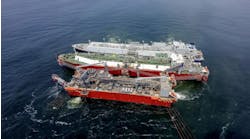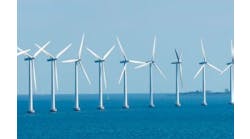FPSO newcomer evolves Producer concept to limit fabrication errors
Technical director, Graeme Mackie explains that the company's key strength lies in its ability to develop design concepts through to production drawings and in assisting companies to bid for floating production, storage, and offloading (FPSO) system conversions. Around 70% of its work is in the offshore market, with 25% in defense and the remaining 5 % made up of miscellaneous work such as quality accreditation.
The company's first major FPSO contract was awarded in December 1995 for the marine design conversion of the Dagmar Maersk, now installed as the North Sea Producer on Conoco's MacCulloch Field. This was followed in January 1996 with a contract from ABB in Leiden, Holland for the marine systems design for Bluewater's Glas Dowr, which involved working with Heerema Hartlepool and Belfast shipyard Harland & Wolff.
The following June, Armstrong Technology won the total marine design conversion work for the Curlew FPSO from Maersk. This was completed a few months ago and the vessel is currently undergoing conversion at Amec's yard on the Tyne.
While much of its early FPSO design work came from European contractors, Armstrong Technology has now broadened its net to bid for work in Australasia and South East Asia, such as supporting bids for Apache Oil's Stag Field in the Timor Sea.
"We have gained a lot of experience in conversions but we have seen drawbacks in this type of work due to the risks involved for the contractors," says Mackie. "It's very difficult to do thorough surveys of suitable vessels before they are purchased, so there is often much more work involved than originally envisaged."
As a result, Armstrong Technology saw a gap in the market for economically produced FPSOs and has subsequently developed its "Producer" series of newbuild vessels. The design has been specifically developed to facilitate construction on fast track projects with minimum design interfaces. "If there are too many companies involved in the process, this is where problems mainly occur," explains Mackie.
Newbuilds vs conversions
In a technical paper given at the Floating Production Systems Conference in Singapore in February this year, Armstrong Technology set out some of the factors that should be taken into account by alliance partners when deciding whether to go for newbuild or converted FPSO units.The paper pointed out that many thousands of design and construction hours could be saved and a stronger negotiating position achieved with a construction yard if alliance partners invested in up-front design time and effort. Unfortunately, however, this conflicts with the competitively tendered super-fast track projects demanded by the oil companies.
Armstrong points out that the only solution to this problem is for contractors to make speculative investments in new-build multipurpose platforms with the design margins to cope with a variety of development options. Companies such as Statoil, Bluewater, and Smedvig that have made this investment have successfully turned the problem into commercial opportunities. So far Armstrong's basic "Producer" design concept has been bid on two contracts in the North Sea and South East Asia with other companies completing the topsides. It is most likely that vessels would be built in the Far East, despite the fact that some projects carried out there have recently run into problems. Mackie believes it is unfair to blame the Asian shipyards for mistakes made in the past, putting these down to poor design and management.
The Producer series is designed for modular installation to allow simultaneous but separate construction of the hull, the accommodation and the control and aviation facilities. This process means that parallel fabrication activities can be carried out at different yards at the same time, with the hull being towed from the Far East to tie into fabrication schedules of the various modules.
The principal dimensions for the vessel have been selected with regard to the wave characteristics of some of the most extreme marine environments such as the West of Shetlands, with a design life of 25 years and corresponding fatigue life of 50 years.
In addition to providing the vessel design drawings, Armstrong Technology calculates all the dynamic loads for the topsides. "The common area of error in FPSO design seems to be on the platform side, which is where we have considerable expertise," says Mackie. "Our strength lies in minimizing risk both to owners and contractors, and as we have lots of experience in planning how systems interface with each other. We also offer planning and control as part of the package."
Armstrong Technology has already seen strong interest in the Producer series concept. Construction drawings cover designs for 550,000-750,000 bbl storage capacity vessels, although the concept can be extended if required. Current designs are capable of accommodating topsides loads in excess of 6,000 tons and comply with all UK North Sea regulations.
While turret configurations are not specified, so that any type can be accommodated to suit prevailing conditions, the company stresses that the selection of the turret system can have a significant impact on the topsides arrangement and safety philosophy.
Copyright 1997 Oil & Gas Journal. All Rights Reserved.


